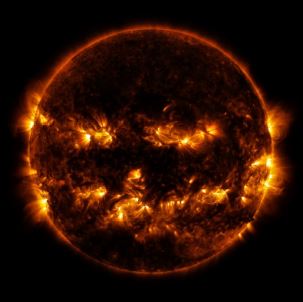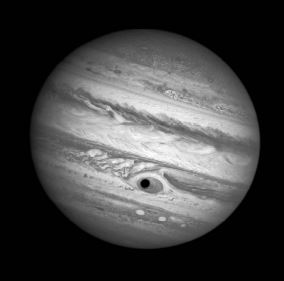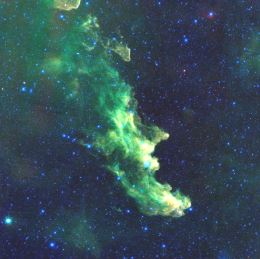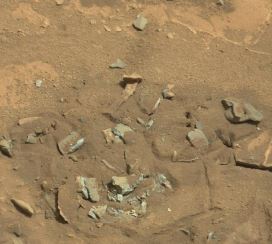Have you ever seen a cloud that looks sort of like a rabbit? Or maybe a rock formation that looks a bit like an elephant? Although you know that a cloud isn’t really a giant rabbit in the sky, it’s still fun to look for patterns in images from nature. Can you spot some familiar spooky sites in the space images below?

Credit: NASA/GSFC/SDO
This might look like the grinning face of a jack-o’-lantern, but it’s actually a picture of our Sun! In this image, taken by NASA’s Solar Dynamics Observatory, the glowing eyes, nose and mouth are some of the Sun’s active regions. These regions give off lots of light and energy. This causes them to appear brighter against the rest of the Sun. Active regions are constantly changing locations on the Sun. On the day this image was captured, they just happened to look like a face!

Credit: NASA/ESA/A. Simon (Goddard Space Flight Center)
This is a Hubble Space Telescope image of Jupiter. Do you notice something that looks like a big eye peeking back at you? That’s actually the shadow of Jupiter’s moon Ganymede as it passed in front of the planet’s Great Red Spot. Jupiter’s Great Red Spot is a gigantic, oval shaped storm that is larger than Earth and is shrinking. It has been on Jupiter for several hundred years, and its winds can swirl up to 400 miles per hour!

Credit: NASA/JPL-Caltech
Can you see the profile of a witch in this image? This image, from NASA’s Wide-Field Infrared Survey Explorer, shows the Witch Head nebula. The nebula is made up of clouds of dust heated by starlight. These dust clouds are where new stars are born. Here, the dust clouds happen to be in the shape of an open mouth, long nose and pointy chin.

Credit: NASA/JPL-Caltech/Univ. of Wisc.
The Black Widow Nebula looks like a giant spider in space. It is a huge cloud of gas and dust containing massive young stars. Radiation and winds from these stars push the dust and gas around, creating a spider-like shape. This image is from NASA’s Spitzer Space Telescope.

Credit: NASA/JPL-CALTECH/MSSS
Did a skeleton lose one of its leg bones on Mars? Nope! It’s just an image of a Martian rock. NASA’s Curiosity rover captured this image. The rock was probably shaped to look this way over time by wind or water. If life ever existed on Mars, scientists expect that it would be small organisms called microbes. So, it isn’t likely that we’ll ever find a large fossil on Mars!
To learn some fun planet facts and make a planet mask, check out NASA Space Place: https://spaceplace.nasa.gov/planet-masks


